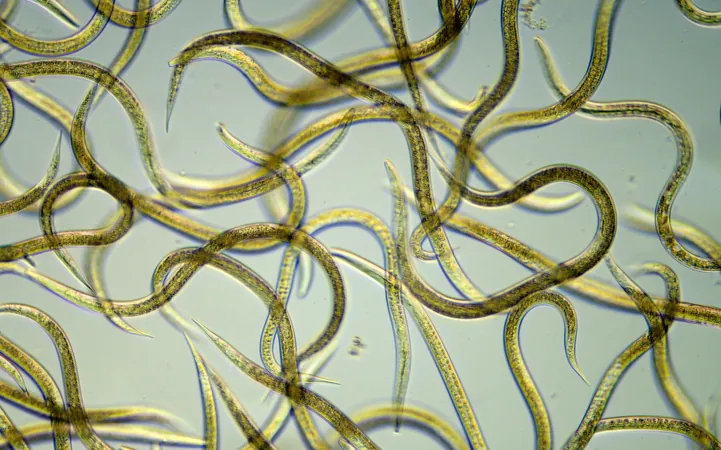
Worm Towers: Nature's Living Structures Built by Nematodes That Baffle Scientists
2025-06-07
Author: Yu
In an extraordinary discovery that blurs the line between myth and reality, scientists have documented nematodes forming astonishing vertical structures, dubbed "worm towers," in the wild. This phenomenon, thought to exist only in laboratory settings, has now been observed in decaying fruit across orchards in Germany.
An international research team, including experts from the Max Planck Institute of Animal Behavior and the University of Konstanz, has presented the first direct evidence of these living towers, revealing how nematodes band together to improve their survival under stressful conditions.
From Lab to Nature: A Groundbreaking Discovery
For years, the scientific community speculated about the existence of these structures outside controlled environments, but no concrete evidence had surfaced—until now. The excitement was palpable when Serena Ding, a senior researcher, witnessed footage of these natural towers for the first time.
"For so long, natural worm towers existed only in our imaginations, but with the right equipment and plenty of curiosity, we found them hiding in plain sight," she exclaimed.
The Journey of Discovery in German Orchards
Ryan Greenway, a dedicated researcher at MPI-AB, tirelessly combed through rotting apples and pears with a digital microscope. His efforts were rewarded when he observed these impressive clusters of worms forming upright structures in their natural habitat.
More Than Just a Pile of Worms
Contrary to what one might think, these worm towers represent more than a chaotic assembly of nematodes. Daniela Perez, the lead author of the study, emphasized that these towers function as a "superorganism in motion." During their observations, each tower was primarily composed of one species of nematode in a resilient, immobile larval state known as "dauer."
Remarkably, these towers demonstrated the ability to respond to external stimuli, detach from surfaces, and cling to passing insects like fruit flies, showcasing group movement on a microscopic scale.
Lab Experiments Reveal More Surprises
To further explore this phenomenon, Perez replicated the conditions in the lab, using the well-studied nematode species Caenorhabditis elegans. When placed on a food-free agar surface, the starved worms began forming towers within two hours, which maintained stability for over 12 hours and extended exploratory "arms" into their surroundings.
Climbing Together: The Mechanics Behind the Towers
While the towers in natural settings consisted mainly of dauer-stage worms, the lab findings revealed that adults and other larval stages were also capable of building these formations, suggesting the behavior could be more widespread than previously understood.
Intriguingly, the structure showed no signs of specialization; worms at the bottom were just as mobile and fertile as those perched on top, challenging existing notions about role differentiation within the towers.
A Peek into Cooperation and Evolution
This egalitarian cooperation among nematodes raises compelling questions about the evolution of collective behaviors in nature. What begins as a cooperative effort in a tower could shift into a complex system influencing survival strategies.
Unlocking New Research Frontiers
Nematodes have now joined the ranks of a select group of animals, like slime molds and fire ants, that utilize body-linking for collective locomotion. With this breakthrough, researchers aim to explore the evolution of collective dispersal using accessible genetic tools available for C. elegans.
As scientists continue to unravel the complexities of cooperation in various species, the humble worm tower springs forward as a new cornerstone in understanding how even the smallest creatures can work together toward a common goal.
What was once restricted to the confines of a lab has now transformed into a captivating natural wonder, showcasing the remarkable ways in which nematodes utilize their unique abilities to thrive in their environments.
This groundbreaking study has been published in the renowned journal Current Biology.


 Brasil (PT)
Brasil (PT)
 Canada (EN)
Canada (EN)
 Chile (ES)
Chile (ES)
 Česko (CS)
Česko (CS)
 대한민국 (KO)
대한민국 (KO)
 España (ES)
España (ES)
 France (FR)
France (FR)
 Hong Kong (EN)
Hong Kong (EN)
 Italia (IT)
Italia (IT)
 日本 (JA)
日本 (JA)
 Magyarország (HU)
Magyarország (HU)
 Norge (NO)
Norge (NO)
 Polska (PL)
Polska (PL)
 Schweiz (DE)
Schweiz (DE)
 Singapore (EN)
Singapore (EN)
 Sverige (SV)
Sverige (SV)
 Suomi (FI)
Suomi (FI)
 Türkiye (TR)
Türkiye (TR)
 الإمارات العربية المتحدة (AR)
الإمارات العربية المتحدة (AR)